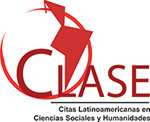Suspected Inhalation Injury and other Factors related to Mortality in Hospitalized Burn Patients in Peru
DOI:
https://doi.org/10.23857/dc.v7i3.1968Palabras clave:
Burns, Inhalation, Accidents.Resumen
Inhalation Injury is a risk factor for mortality in burn patients; the diagnosis is suspected by clinical history and findings. Aims: Determine if suspected inhalation injury is a risk factor for mortality in burn patients and if there are other risk factors. Retrospective cohort study that included 156 medical records in the HNAL between 2015-2016. Dependent variable was mortality and independent variables included suspected inhalation injury, sex, age, depth and extent of burn and place of origin. Relative risks were estimated. The HNAL Thermic Registry was used for data recollection.Descriptive analyzes performed with median and interquartile ranges and relative and absolute frequencies for categorical variables. Fisher, Chi square and U Mann Whitney tests were used in bivariate analysis. Poisson Regression was used in multivariate analysis. Overall mortality of 9%. 46% of patients had suspected inhalation injury. Percentage of deceased patients was higher in those exposed to suspected inhalation injury (16.7% vs. 2.38%), place of origin outside Lima (16.7% vs. 5.56%), third-degree burn (13.3% vs. 1.72%) and median extent of burn (56.3 vs. 10). Suspected inhalation injury [RR: 6.24 (IC95% 1.48-26.3) (p:0.013)], third degree burn [RR 6.86 (IC95% 1.17-40.2) (p:0.033)], burn extension greater than 11% [RR 6.12 (IC95% 1.77-21.1) (p:0.004)] and place of origin outside Lima [RR 3.69 (IC95% 1.54-8.86) (p:0.003)] were significant in multivariate analysis. Suspected inhalation injury, third degree burn, extension greater than 11% and place of origin outside Lima are risk factors for mortality in burn patients.
Citas
Palmieri TL. Inhalation injury: research progress and needs. J Burn Care Res. 2007;28:549–54.
Foster KN, Holmes JH. Inhalation Injury: State of the Science 2016. J Burn Care Res. 2017 May/Jun;38(3):137-141.
Lin CC, Liem AA, Wu CK, Wu YF, Yang JY, Feng CH. Severity score for predicting pneumonia in inhalation injury patient. Burns. 2012 Mar;38 (2):203-7.
Head JM. Inhalation injury in burns. Am J Surg. 1980;139 (4):508–12.
Nieman GF, Clark Jr WR, Wax SD, Webb SR. The effect of smoke inhalation on pulmonary surfactant. Ann Surg. 1980;191(2):171–81.
Chen MC, Chen MH, Wen BS, Lee MH, Ma H. The impact of inhalation injury in patients with small and moderate burns. Burns. 2014 Dec;40(8):1481-6.
Suzuki M, Aikawa N, Kobayashi K, Higuchi R. Prognostic implications of inhalation injury in burn patients in Tokyo. Burns. 2005 May;31(3):331-6.
You K, Yang HT, Kym D, et al. Inhalation injury in burn patients: establishing the link between diagnosis and prognosis. Burns. 2014 Dec;40(8):1470-5.
Alp E, Coruh A, Gunay G, Yontar Y, Doganay M. Risk Factors for Nosocomial Infection and Mortality in Burn Patients. J Burn Care Res. 2012 May-Jun;33(3):379-85.
Burd A. Research in burns – present and future. Indian J Plast Surg. 2010;43(3):11.
Moritz AR, Henriques FC, McLean R. The Effects of Inhaled Heat on the Air Passages and Lungs: An Experimental Investigation. Am J Pathol. 1945 Mar; 21(2): 311–331.
Mlcak RP, Suman OE, Herndon DN. Respiratory management of inhalation injury. Burns. 2007;33(1):2-13.
Shirani KZ, Pruitt Jr BA, Mason Jr AD. The influence of inhalation injury and pneumonia on burn mortality. Ann Surg. 1987;205:82–7.
Albright JM, Davis CS, Bird MD, et al. The acute pulmonary inflammatory response to the graded severity of smoke inhalation injury. Crit Care Med. 2012;40:1113
Wanner A, Cutchavaree A. Early recognition of upper airway obstruction following smoke inhalation. Am Rev Respir Dis.1973;108(6):1421–3.
Walker PF, Buehner MF, Wood LA, et al. Diagnosis and management of inhalation injury: an updated review. Crit Care. 2015; 19: 351.
ISBI Practice Guidelines Committee. ISBI Practice Guidelines for Burn Care. Burns 42 (2016) 953–1021.
Wiegering G. Factores pronóstico de las complicaciones en el paciente gran quemado. [master's thesis] [Peru]: University of San Martin de Porres; 2015. 75 p.
Zegarra D, Linares G. Etilogia de las quemaduras y perfil epidemiologico encontrado en pacientes de la unidad de quemados del Hopital Nacional Carlos Alberto Seguin Escobedo. [master's thesis] [Peru]: University of Universidad Católica de Santa María; 2016.100 p.
Kim Y, Kym D, Hur J, et al. Does inhalation injury predict mortality in burns patients or require redefinition?. PLoS One. 2017; 12(9): e0185195.
Cheng W, Shen C, Zhao D, et al. The epidemiology and prognosis of patients with massive burns: A multicenter study of 2483 cases. Burns. 2019 Mar 2. pii: S0305-4179(18)30694-6.
Luo G, Peng Y, Yuan Z, et al. Inhalation injury in southwest China—The evolution of care. Burns. 2010 Jun;36(4):506-10.
Dries DJ, Endorf FW. Inhalation injury: epidemiology, pathology, treatment strategies. Scand J Trauma ResuscEmerg Med. 2013 Apr;19;21:31
Palmieri TL. Inhalation Injury Consensus Conference: Conclusions. J Burn Care Res. 2009 Jan-Feb;30(1):209-10
Pedreros P, Longton B, Whittle V, Villegas C. Inhalation injury in burned patient: A review. Rev ChilEnf Respir 2007; 23:117-124.
Mlcak R, Buffalo M, Jimenez C. Prehospital Management, Transportation, and Emergency y Care. Total Burn Care. 2018:58-65.
American Burn Association. Guidelines for the operation of burn centers. J Burn Care Res. 2007 Jan-Feb;28(1):79-86.
Cochran A. Inhalation injury and endotracheal intubation. J Burn Care Res. 2009 Jan-Feb;30(1):190-1.
Gupta, K., Mehrotra, M., Kumar, P., Gogia, A.R., Prasad, A., & Fisher, J.A. (2018). Smoke inhalation injury: Etiopathogenesis, diagnosis, and management. Indian Journal of Critical Care Medicine, 22, 180-188.
Publicado
Cómo citar
Número
Sección
Licencia
Authors retain copyright and guarantee the Journal the right to be the first publication of the work. These are covered by a Creative Commons (CC BY-NC-ND 4.0) license that allows others to share the work with an acknowledgment of the work authorship and the initial publication in this journal.






